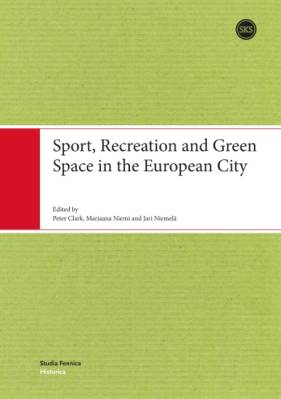Sport, Recreation and Green Space in the European City
Clark, Peter; Niemi, Marjaana; Niemelä, JariProduct information
| Title: | Sport, Recreation and Green Space in the European City | ||
| Authors: | Clark, Peter (Author) Niemi, Marjaana (Author) Niemelä, Jari (Author) |
||
| Product number: | 9789522221629 | ||
| Product form: | Paperback | ||
| Availability: | Delivery in 7-14 workdays | ||
| Price per piece: | 32,00 € (28,07 € vat 0 %) | ||
|
|||
| Publ. product code: | 1319664 |
| Publisher: | Suomalaisen Kirjallisuuden Seura |
| Series: | Studia Fennica Historica 16 |
| Edition: | 1. edition, 2009 |
| Language: | English |
| Pages: | 220 |
| Product family: | Culture Studia Fennica Historica Books in English |
| Finnish library classification: | 91.81 Nykyaika |
| YSO - General Finnish ontology: | viherrakentaminen, ulkoilualueet, liikunta-alueet, urheilukentät, virkistysalueet, puistot, suunnittelu, kaupungit, kaupunkihistoria, kaupunkisuunnittelu |
| Key words: | Community planning, Sport facilities, Sport grounds, Urban Design, Urban construction |
Green space has become a major issue in European cities in recent years as a result of enhanced environmental awareness, urban marketing, planning policy and growing population densities. Up to now, however, the subject of sports areas and grounds has attracted little research, despite the fact that since the First World War such public and private areas - from football pitches and running tracks to golf courses and tennis courts - have often comprised one of the most important and extensive types of green space in the European city.
This book presents a pioneering comparative and multidisciplinary analysis of the development, use and impact of sports areas in the European city from the start of the 20th century up to the present time. Employing a range of historical, spatial and ecological approaches it examines when and why sports areas evolved, the contribution of municipalities and the private sector, the role of gender and class, and the impact on the urban landscape and ecology. Chapters cover urban sports areas in Finland, Britain, the Netherlands, Germany and Italy, illustrating the contrasts in the provision of green space across Europe.
This book presents a pioneering comparative and multidisciplinary analysis of the development, use and impact of sports areas in the European city from the start of the 20th century up to the present time. Employing a range of historical, spatial and ecological approaches it examines when and why sports areas evolved, the contribution of municipalities and the private sector, the role of gender and class, and the impact on the urban landscape and ecology. Chapters cover urban sports areas in Finland, Britain, the Netherlands, Germany and Italy, illustrating the contrasts in the provision of green space across Europe.





